Canon EOS 5D mark III Review
Overview of the 5D Mark III
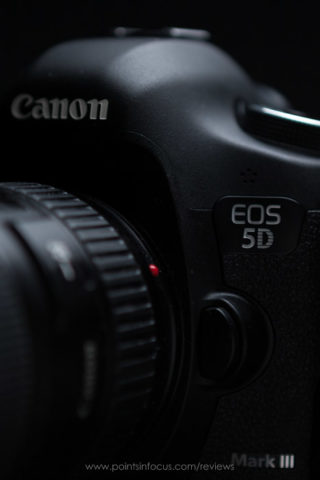 The 5D mark III is a small-pro body. In the past I would have called it a semi-pro body, however, at this point, Canon has elected to include all of the major pro functionality found in the EOS-1D X in the 5D mark III, so small seems more appropriate.
The 5D mark III is a small-pro body. In the past I would have called it a semi-pro body, however, at this point, Canon has elected to include all of the major pro functionality found in the EOS-1D X in the 5D mark III, so small seems more appropriate.
The camera has a 22.3MP 135-format (more commonly called full frame) sensor (36mm x 24mm), that’s been optimized for both still and video capture. The sensor is backed by a Digic 5+ processor that allows for continuous shooting at 6 FPS, and video capture at 1080p at up to 30FPS and 720p at 60 FPS.
Dual card slots, one UDMA7 compatible Compact Flash and one SDXC compatible Secure Digital, are provided for storage.
Metering is provided by the same, or at least a similar, 63-zone dual layer metering system as in the 7D and many of Canon’s lower tier cameras, while the autofocus system has been brought directly from the new EOS-1D X. The combination of AF, frame rate, and buffer make the 5D mark III a reasonable all around camera capable of being used for moderately demanding action as well as more static landscape and architectural work.
Auto Focus: Phase and Contrast Detection
One of my, and I believe many others, biggest complaints about the 5D mark 2 was Canon’s continued use of a limited and out dated AF system. Nikon’s contemporary to the 5D mark 2, the D700, used the same 55-point AF system that Nikon developed for the D3, and in comparison the 9 point + 6 assist point AF system in the 5D mark 2 was tremendously lacking.
AF Hardware
The 5D mark 3 rectifies the pathetic AF issue of the 5D mark II in spades. Canon has used, at least in part, their all-new 61-point system between the EOS-1D X and 5D mark III. There are still subtle differences between the two in terms of features, the biggest of which being the EOS-1D X’s ability to do face detect AF while in 61-point auto AF mode and color tracking due to the more sophisticated 100K pixel RGB meter. Beyond that, the differences are largely limited to minor configuration issues.
When it comes to the AF hardware, my inner engineer geeks the heck out with Canon’s AF systems. At the core of the new pro-level AF system is a new phase detect sensor that’s provides 61 separate AF points using a combination of up to 4 different sensor sets per point.
By using several different sites to compose a single point, Canon can deal with the physical issues imposed by a phase detect AF system. Optimization of a sensor for precise measurement of focus for large aperture lenses generally limits the maximum aperture that a sensor can measure focus from. Conversely, a sensor designed to address the focus of a smaller aperture lens, and it will have to make other tradeoffs, like being less accurate with fast lenses or less capable in low light due to noise.
The new 61-point system is built around 3 different types of sensor stripes that overlap to provide specified performance. The meat of the system are the f/5.6 capable sensors that provide horizontal line sensitivity for all 61-points, and vertical line sensitivity for all of 21-of the central points, making them cross type points at f/5.6 and faster. Next are a set of f/4 capable sensors that cover the 2 center columns of each of the 2 20-point wings, resulting in 20 peripheral points that are cross sensitive with lenses f/4 and faster. Finally, there are the high precision sensors for f/2.8 and faster lenses that are arranged in diagonal crosses backing the 5 center most points in the center most column.
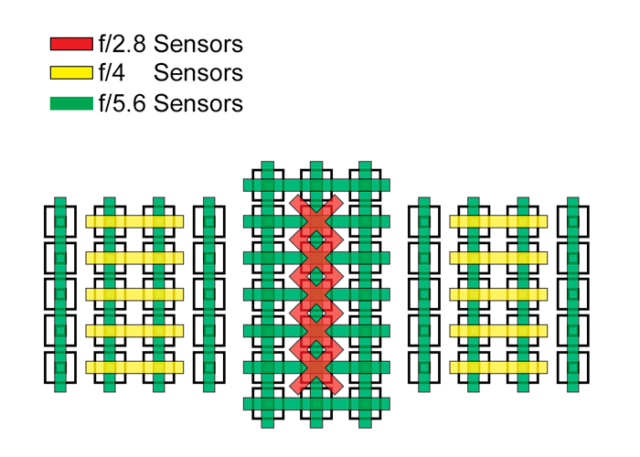
Additionally, with the release of the version 1.2.1 firmware, Canon has devised a way to make use of the geometry of the central stripes to allow focusing with lenses and lens and teleconverter combinations with apertures up to f/8. With f/8 lenses, the center point is the only selectable point. However, unlike previous f/8 capable systems, it will function as a cross type point. Moreover, the points above and below will function as vertical line sensitive assist points, and the points to the left and right as horizontal line sensitive assist points.
The camera uses its knowledge of the attached lens, to select which AF points and which of their sensor strips will be used for focus information. This behavior isn’t unique to the 5D mark 3’s AF system. In fact, EOS-1D bodies have been doing it since the mid-90s when Canon released their first 45-point professional AF system. What is new is the extent to which the AF system’s behavior changes by lens.
Aperture is no longer the simple adefining behavior for AF point selection; the system now considers the optics of the lens including distortion and the resulting geometry of the incident light to disable points or groups of points that won’t produce accurate data. The behavior of this new system is so much more complicated that Canon has broken their entire line of EF lenses into 8 groups, A-H, which reflect which points and their capabilities when using a lens in each group.
Suffice to say the complexity of this system can be a bit overwhelming, at least if you’re trying to track every little detail. However, in practice the camera only will present the AF points that can be used for selection, and will use the best capabilities of the points that are available where possible.
Further, Canon provides an indication as to whether the selectable points are cross type or not, by flashing the non-cross-type points in AF point selection mode to indicate their reduced capabilities. Alternatively, if you simply don’t want to deal with non-cross type points, you can filter the displayed and selection of points to only cross type points via the AF-5 menu.
Though the new system is significantly more complex than previous EOS AF systems, including the ones on Canon’s EOS-1D bodies, it works phenomenally well. I’ve yet to have a situation where I’ve missed focus that I can definitely blame on the camera and not me screwing something up. Focus accuracy has been spot on for me, even with fast lenses that I’ve had trouble getting to focus well in the past.
The only real trouble with this new system is with 3rd party lenses. The camera determines the AF capabilities based on the ID reported by the lens. Since Canon doesn’t issue IDs to 3rd party manufacturers, they pick IDs that they don’t think will cause issues. In the past, this hasn’t been much of a problem; at least you wouldn’t suddenly lose 50% of your active AF points. However, with this new system, the ultimate implication of this is that you may be stuck with significantly reduced capabilities that don’t readily make sense given the aperture of the lens depending on what ID the manufacturer decided to use.
Take, for example my Sigma 150mm f/2.8 EX DG HSM macro lens. The lens reports with the same ID as Canon’s 180mm f/3.5L USM macro lens, as such, it’s classified by the camera as a Group G lens, which disables nearly half of the AF points, as well as any of the high-precision f/2.8 stripes.
The other concern I have going forward, is how Canon will treat lenses released after the camera is discontinued. In 3 or 5 years, will Canon still release firmware updates that add support for new lenses if necessary? There’s a certain level where this looks like a degree of planned obsolesce, and I don’t like that. If Canon releases a must have EF 14-24mm f/2.8L USM in 5 years, how exactly will my 5D mark III respond to it or will Canon be pushing me to buy a 5D mark IV to be able to use new lenses?
Phase Detect AF Software
The software and user interface side of the AF system also has been completely overhauled from the previous cameras. The new system draws heavily on the functionality and capabilities introduced with the EOS 7D. However, Canon has gone even further in restructuring all the autofocus options to make them easier to find and access. Canon has moved all the AF options from Custom functions, into a new set of top-level AF menus. Moreover, AF Point expansion has been moved into the AF point selection system, and a number of new features have been added to make the system even more customizable and flexible.
| New AF Menu |
|---|
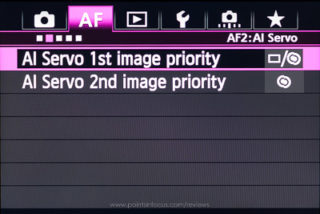 |
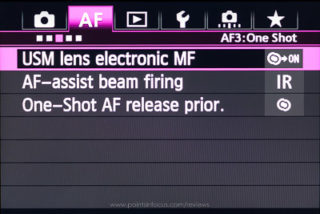 |
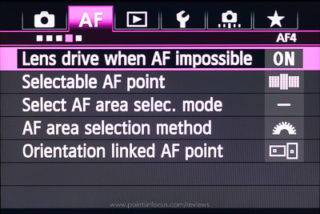 |
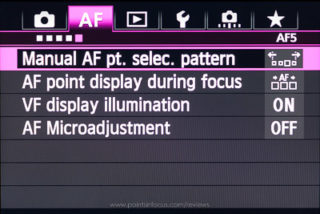 |
The 5D mark 3 has all of the AF point selection modes that were introduced starting with 7D. These are single-point spot, single-point, 2 expansion modes (top/bottom/left/right, and surrounding 8 points), zone AF, and full automatic point selection.
Most DSLR users should be familiar with the single point and automatic area modes, as they behave the same as they do pretty much on any other camera. 7D users will be familiar with the new spot, and zone AF modes, bear mentioning.
Single Point Spot mode is largely identical in function to single point mode, however, the area of the AF sensor that’s used for focusing is reduced to insure that the camera focuses on exactly what’s under the AF box and not somewhere else.
Spot AF is ideal for situations where you have subjects that are angularly close together, but far apart by distance, including overlapping situations like shooting through a fence or leaves. The tradeoff for spot AF is that due to the camera only using a small portion of the AF sensors, the AF system may hunt more in extremely defocused cases, or fail to lock when there is a lot of camera movement.
The expanded AF area modes aren’t new to Canon AF systems, what is new is that they’ve been promoted form a custom function setting to something that can be readily accessed through the AF point selection mode. This makes using surrounding assist points much easier than it has been in the past. The 5D mark III offers two expansion modes, one that uses only the points above, below, left and right of the active point, and one that uses all 8 of the surrounding points.
Zone AF is new to the 5D and EOS-1D X lines, and performs a similar function to full automatic selection mode. However, instead of using the whole grid, it uses one of 9 zones each limited an specific area of the AF pattern. I don’t use zone AF much if at all, though I can certainly see times when it might be more useful than the full 61-point mode.
Finally, Canon has incorporated a refinement to the automatic AF point selection mode when used with AI Servo focusing. It’s now possible to manually select the AF point that will be used to establish the initial focus lock instead of the camera using the center AF point.
In my experience, one of the biggest issues for tracking focus is simply the density of the AF grid and therefore the camera’s ability to maintain a continuous lock on the subject. On a camera like a 60D, or 5D mark II, there simply aren’t enough AF points to cover enough of the frame or with enough density. Because of that, I find the AF system can lose track of a moving subject, especially smaller ones. With the dense field in the 5D mark III, there doesn’t seem to be much of an issue with losing subjects as the move across the AF pattern.
I’m not a heavy user of AI Servo and automatic point selection; however, every time I’ve needed it it’s been extremely reliable at maintaining focus. Moreover, in AI Servo and automatic point selection, you can select which point will be used to initially establish focus.
One Shot performance has been nothing short of stellar too. In fact, since I started shooting with the 5D mark III, I’ve found very few images that are out of focus due to something the camera did wrong, and not something readily realized as user error (for example, zooming a non-parfocal lens after focusing).
AF Micro Adjustments are supported either as one global adjustment or for up to 40 registered lenses, though you cannot register multiple lenses of the same type, and lens and teleconverter combinations. The limitation on lenses of the same type is strange to me, given that the camera requires a serial number (often read from the lens or otherwise user supplied) when it stores the lens. From a programming standpoint, a hash of the lens name and serial number should be sufficient to allow multiple lenses of the same type to be registered.
The system includes more sophistication than previous Canon micro adjustment systems. Zoom lenses can now be adjusted at both the wide and telephoto positions. Intermediate zoom positions are interpolated between the two extremes, which may or may not result in accurate results.
I’ve found that the AF system is generally quite good out of the box. Though there certainly are camera-to-camera variations. I haven’t needed to use AF micro adjustments, even with historically difficult to focus lenses like my Sigma 150mm f/2.8 macro.
The biggest missing feature in the AF micro adjustments system—and it’s not as if Canon is alone here—is the inclusion of an auto-adjustment system. Since the camera has the ability to focus and measure contrast with the sensor as well as the AF system, I think it’s entirely reasonable that the camera should be able to run a self-adjustment routine that uses the features already in the camera to measure and make an adjustment. Such a system would make AF micro adjustments as accurate as possible and could allow them to be done rapidly and any given situation instead of the current time consuming process with test charts.
The biggest missing feature in the 5D mark III’s AF system, isn’t even directly part of the AF system, but the 100,000 pixel meter in the EOS-1D X. Because of that, the AF system doesn’t support face detection or color tracking when in 61-point mode.
Some might argue that these aren’t necessary features. However, based on my experience with Nikon’s 3D Color Tracking AF system, color tracking can be very useful as a means to differentiate small subjects in busy scenes. That said, even without it, the AF system is dense enough that as long as you continue to keep the subject inside the AF are, the camera will generally be able to continue tracking it.
Two other AF features I use extensively are Orientation Linked AF Points, and Registered AF Points.
With Orientation Linked AF Points, the camera stores the selected point and area mode for each of the 3 orientations (landscape, portrait grip up, and portrait grip down) separately, so that rotating the camera changes the selected AF point and mode. I find this useful when I need to be able to quickly rotate from landscape to portrait orientation while keeping my active AF point in the same general area of the frame.
Registered AF points, are also a feature I find invaluable. This feature allows you to save a AF point and area mode (for each orientation if Orientation linked AF points is enabled), and recall or activate it immediately while shooting. This feature works exceptionally well with rear button focusing when using both the AF-On and exposure lock buttons to activate the normal and registered AF points.
I make extensive use of the setup when photographing birds, keeping a single point on the main AF button for shooting static shots, and having the 61-point auto mode on the secondary button in the event I need to rapidly jump to a tracking shot.
On top of the various point modes, Canon has added 6 different customizable cases for dealing with tracking moving subjects. Each of these cases is optimized for a different kind action, from continuous movement that’s frequently interrupted by obstructions, or erratic subjects that accelerate in any direction. Further, each of the 6 cases can be fine-tuned to suit your needs or preferences.
The AF tracking cases aren’t something that I’ve ever really used or needed to change. I’ve yet to encounter a situation where the first general purpose case didn’t provide satisfactory performance for me. Though I can certainly see how it might be different for photographers shooting certain sports.
In any event, the individual AF tracking performance cases (AF1 menu) again move setting that were buried in custom functions into a centralized easily accessible area. And of course, switching from say case 1 to case 3 is much easier than going through 3 different custom functions and adjusting them and having to worry about adjusting them back if you want to revert to the original settings.
Live View AF
In live view, the 5D mark 3 supports contrast detection AF, called Live Mode, in addition to lowering the mirror and using the phase detection sensor, called Quick Mode. Further, Live mode is available in two variants, normal Live Mode, which focuses on the contents in the white box, and Face Detect Live Mode, which will search the image for faces and attempt to focus on them.
Since Live mode is contrast based and not phase based, the capabilities and restrictions are different from the main AF system. In Live mode, continuous AF is not available, this includes when shooting video. On the other hand, since the contrast AF system isn’t affected by the geometry of lens aperture, the camera can focus in Live mode with any lens and teleconverter combination resulting in any aperture (such as the f/11 of a EF 400mm f/5.6L with a 2x teleconverter).
Auto focus in live view is staggeringly accurate, as it should be since focus is being driven by the actual image on the sensor. What Live view AF is not, is fast. Additionally servo AF is not available in live view, either in still or video mode. Moreover, in video mode, live view focusing has a host of issues that I’ll come back to when I discuss the videography performance of the camera later on.
All told, there’s very little I can complain about with the autofocus system in the 5D mark 3. It’s a pro-level system with pro-level performance, which is what it should be.

Comments
There are no comments on this article yet. Why don't you start the discussion?